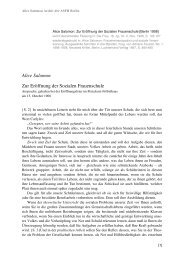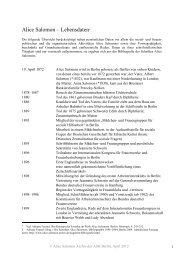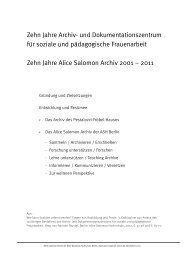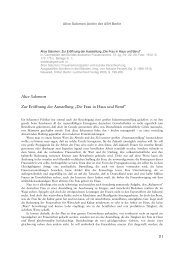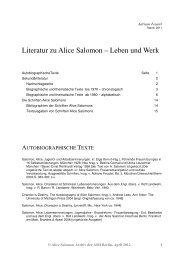Teaching Gender in Social Work - MailChimp
Teaching Gender in Social Work - MailChimp
Teaching Gender in Social Work - MailChimp
Create successful ePaper yourself
Turn your PDF publications into a flip-book with our unique Google optimized e-Paper software.
The aim is to alternate between the fictive and the real world and, by means<br />
of reflection, to f<strong>in</strong>d new mean<strong>in</strong>gs and resonance around the theme under<br />
exam<strong>in</strong>ation. Distanc<strong>in</strong>g promotes critical reflection dur<strong>in</strong>g and after the<br />
work<strong>in</strong>g session. 16<br />
The follow<strong>in</strong>g general phases have been def<strong>in</strong>ed <strong>in</strong> a drama process, but<br />
they are not obligatory; 17<br />
1. The first phase: the start (orientation and warm<strong>in</strong>g up, animat<strong>in</strong>g<br />
participants);<br />
2. The second phase: an <strong>in</strong>troduction to the theme under<br />
exam<strong>in</strong>ation (learn<strong>in</strong>g about the background);<br />
3. The third phase: explor<strong>in</strong>g the conflict and <strong>in</strong>tensify<strong>in</strong>g it (the<br />
ma<strong>in</strong> problem related to the theme is explored and <strong>in</strong>tensified);<br />
4. The fourth phase: deepen<strong>in</strong>g (empathis<strong>in</strong>g with and <strong>in</strong>quir<strong>in</strong>g <strong>in</strong>to<br />
the background and different perspectives of the theme under<br />
exam<strong>in</strong>ation);<br />
5. The fifth phase: clos<strong>in</strong>g a plot level (the narrative level of the theme<br />
is closed <strong>in</strong> order to move on to a more general and abstract level);<br />
6. The sixth phase: abstract<strong>in</strong>g (process<strong>in</strong>g the theme at a symbolic<br />
and /or artistic level);<br />
7. The seventh phase: reflection and feedback (process<strong>in</strong>g feel<strong>in</strong>gs,<br />
thoughts and new ideas).<br />
Although process drama does not require a manuscript, it usually needs<br />
pretexts or some other stimulus (photographs or films, for <strong>in</strong>stance), which help<br />
people to focus on the topic and provide a particular po<strong>in</strong>t of departure for the<br />
work<strong>in</strong>g session. The ma<strong>in</strong> function of the pretext is to stimulate and offer a<br />
framework for the whole work<strong>in</strong>g process. The pretext can be, for example, a<br />
short story written by the teacher or by students, or a text copied from exist<strong>in</strong>g<br />
16<br />
Barbara Bowell and Brian S. Heap, Plann<strong>in</strong>g Process Drama. (London: David Fulton, 2001), and Hannu<br />
Heikk<strong>in</strong>en and Tuija Leena Viirret, Draamakasvatuksen teillä: tutkimus TIE (Theatre-In-Education) -projektista.<br />
(Jyväskylä: Jyväskylän yliopisto, 2003) and O’Neill, 1995.<br />
17<br />
Pirjo Kanerva and Viivi Viranko, Aplodeja etsijöille. Näkökulmia draamaan sekä taidekasvatuksena että opetusmenetelmänä.<br />
(Hels<strong>in</strong>ki: Laatusana, Äid<strong>in</strong>kielen opettaja<strong>in</strong> liitto, 1997), 144−5.<br />
50



